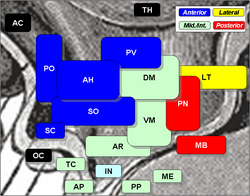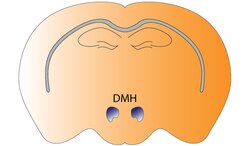| Dorsomedial hypothalamic nucleus | |
|---|---|
 Dorsomedial nucleus is 'DM', at center, in green. | |
 The dorsomedial hypothalamus of the mouse brain | |
| Details | |
| Identifiers | |
| Latin | nucleus dorsomedialis areae hypothalamicae intermediae |
| MeSH | D004302 |
| NeuroNames | 397 |
| NeuroLex ID | birnlex_1558 |
| TA98 | A14.1.08.917 A14.1.08.922 |
| TA2 | 5728 |
| FMA | 62331 |
| Anatomical terms of neuroanatomy | |
The dorsomedial hypothalamic nucleus is a nucleus of the hypothalamus. It is involved in feeding, drinking, body-weight regulation and circadian activity.[1] More specifically, it is a necessary component for the expression of numerous behavioral and physiological circadian rhythms. The dorsomedial hypothalamic nucleus receives information from neurons and humors involved in feeding regulation, body weight and energy consumption, and then passes this information on to brain regions involved in sleep and wakefulness regulation, body temperature and corticosteroid secretion.[2]
Function[edit]
The dorsomedial hypothalamic nucleus (DMH) receives its circadian information from the suprachiasmatic nucleus, both directly and via subparaventricular zone, and senses leptin and other feeding cues, but it is also possible that it contains its own feeding-entrained oscillator (FEO). This still has yet to be proven in vitro. The DMH sends information to the ventrolateral preoptic area, locus coeruleus, and orexinergic neurons in order to aid in the regulation of wakefulness. The DMH is also involved in the regulation of hypothalamic outflow to the autonomic nervous and endocrine systems.[3] Almost all major nuclei and areas of the hypothalamus feed information to the DMH.[4] The inhibition of neuronal activation using muscimol in the DMH inhibited 85% of heart rate response and 68% of blood pressure response to air stress. This displays that the DMH also plays a role in the increase of heart rate and blood pressure as cardiovascular responses to stress.[5] The DMH is also a part of the pathway corticotrophin-releasing hormone (CRH) takes when it is secreted by the paraventricular nucleus of the hypothalamus, and it is involved in the flow from the sympathetic nervous system to the adrenal gland.[6]
Clinical significance[edit]
Damage[edit]
It was found in the study done by Gooley et al. that lesions in DMH neurons in rats prevented food entrainment of wakefulness, locomotor activity, and core body temperature. This further verifies its role in oscillation between feeding and circadian rhythm.[3] Lesions in the DMH of rats also caused a weakened level of response to the feeding-stimulant insulin.[6]
References[edit]
- ^ Chou, Thomas C.; Scammell, Thomas E.; Gooley, Joshua J.; Gaus, Stephanie E.; Saper, Clifford B.; Lu, Jun (November 2003). "Critical role of dorsomedial hypothalamic nucleus in a wide range of behavioral circadian rhythms". The Journal of Neuroscience. 23 (33): 10691–702. doi:10.1523/JNEUROSCI.23-33-10691.2003. PMC 6740926. PMID 14627654.
- ^ Gooley, Joshua J; Schomer, Ashley; Saper, Clifford B (March 2006). "The dorsomedial hypothalamic nucleus is critical for the expression of food-entrainable circadian rhythms". Nature Neuroscience. 9 (3): 398–407. doi:10.1038/nn1651. PMID 16491082. S2CID 8250782.
- ^ a b Mieda, Michihiro; Williams, S. Clay; Richardson, James A.; Tanaka, Kohichi; Yanagisawa, Masashi (August 2006). "The dorsomedial hypothalamic nucleus as a putative food-entrainable circadian pacemaker". Proceedings of the National Academy of Sciences of the United States of America. 103 (32): 12150–5. doi:10.1073/pnas.0604189103. PMC 1567710. PMID 16880388.
- ^ Thompson RH, Swanson LW (July 1998). "Organization of inputs to the dorsomedial nucleus of the hypothalamus: a reexamination with Fluorogold and PHAL in the rat". Brain Research Reviews. 27 (2): 89–118. doi:10.1016/S0165-0173(98)00010-1. PMID 9622601. S2CID 28298757.
- ^ Stotz-Potter, Elizabeth H.; Willis, Lynn R.; DiMicco, Joseph A. (February 1996). "Muscimol acts in dorsomedial but not paraventricular hypothalamic nucleus to suppress cardiovascular effects of stress". The Journal of Neuroscience. 16 (3): 1173–9. doi:10.1523/JNEUROSCI.16-03-01173.1996. PMC 6578823. PMID 8558246.
- ^ a b Bernardis, Lee L.; Bellinger, Larry L. (September 1998). "The dorsomedial hypothalamic nucleus revisited: 1998 update". Proceedings of the Society for Experimental Biology and Medicine. 218 (4): 284–306. doi:10.3181/00379727-218-44296. PMID 9714072. S2CID 42864935.